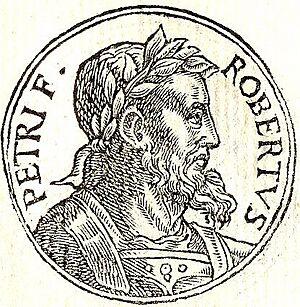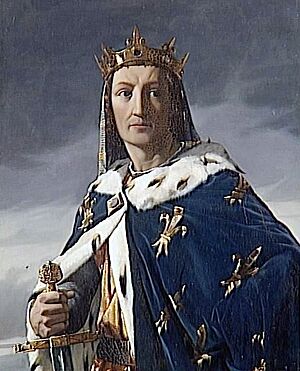Battle of Sandwich (1217) facts for kids
Quick facts for kids Battle of Sandwich (1217) |
|||||||
|---|---|---|---|---|---|---|---|
| Part of First Barons' War | |||||||
 The Battle of Sandwich, showing the capture of the French flagship and the killing of Eustace the Monk |
|||||||
|
|||||||
| Belligerents | |||||||
| Kingdom of England | Kingdom of France | ||||||
| Commanders and leaders | |||||||
| Hubert de Burgh Philip d'Aubigny Richard FitzRoy |
Robert of Courtenay Eustace the Monk |
||||||
| Strength | |||||||
| 16–18 large ships 20 smaller ships |
10 large ships 70 supply vessels |
||||||
| Casualties and losses | |||||||
| Unknown | 1 large ship, 36 knights 64 supply vessels |
||||||
The Battle of Sandwich, also known as the Battle of Dover, happened on 24 August 1217. It was an important naval battle during the First Barons' War in England. An English fleet, led by Hubert de Burgh, fought a French fleet. The French ships were commanded by Eustace the Monk and Robert of Courtenay. The battle took place off the coast of Sandwich, Kent.
The English won a big victory. They captured the main French ship and most of their supply vessels. This forced the remaining French ships to go back to Calais. The French fleet was trying to bring supplies and more soldiers to Prince Louis. Prince Louis, who later became King Louis VIII of France, had French forces in London at that time. The English ships attacked from a good position, catching the French off guard. Eustace the Monk, a famous pirate, was captured and then executed. This battle helped convince Prince Louis to give up his plan to conquer England. A peace treaty, called the Treaty of Lambeth, was signed soon after.
Contents
Who Was Eustace the Monk?
Eustace the Monk was once part of a religious group. But he left that life and became a pirate. He worked with his brothers and friends. His early success made him famous, and many lawless men joined him. His pirates became a big problem for ships sailing in the English Channel.
From 1205 to 1208, Eustace worked for King John I of England. King John allowed him to take control of the Channel Islands. Eustace used Winchelsea as his base in England. But in 1212, Eustace changed sides and started working for France. He was then chased out of England. In 1215, his ships helped transport war machines for English nobles who were against King John. When Prince Louis sailed to London, he traveled with Eustace's fleet. Eustace's help allowed Louis to quickly capture London and the Cinque Ports.
Why Did the Battle Happen?
After a major defeat at the Battle of Lincoln in May 1217, Prince Louis was in a difficult spot. He stopped trying to capture Dover Castle and went back to London. Louis wanted to end the war and agreed to meet with supporters of the young English king, Henry III of England.
William Marshal, 1st Earl of Pembroke, who won the Battle of Lincoln, and Prince Louis almost reached an agreement. However, the Pope's approval was needed to pardon some bishops who had joined Louis. This would take a long time. So, the talks broke down. Louis then heard that more soldiers and supplies were coming from France. This news made him decide to keep fighting.
Prince Louis had been invited to England by English nobles who were unhappy with King John. This was not just a war between countries. It was also a conflict between different groups within England.
The Sea Battle of Sandwich
On 24 August, a clear day, the French fleet left Calais. Eustace the Monk had prepared the ships. But Robert of Courtenay was in charge of the knights and soldiers. Prince Louis's wife, Blanche of Castile, also helped organize the French effort.
The English forces were led by Philip d'Aubigny, who was in charge of the southeastern coast. The Earl of Pembroke gathered sailors from the Cinque Ports. These sailors had complaints about King John. But Pembroke convinced them to fight by promising them great rewards if they won.
Eustace's own ship, the Great Ship of Bayonne, led the French fleet. Robert de Courtenay was the main commander, with Eustace as his second-in-command. There were 36 knights on the main French ship. The next three ships carried between 100 and 125 knights. The remaining six ships carried men-at-arms. There were also 70 smaller ships carrying supplies. All the French troopships were very full. The main ship even carried a large trebuchet (a type of catapult) and horses for Prince Louis.
The English ships were generally smaller than the French ones. However, the Earl of Pembroke provided a large cog (a type of ship). Hubert de Burgh, as the chief justice, took command of the English fleet. This fleet had between 16 and 18 large ships and 20 smaller ones. In total, there were no more than 40 English ships. King John's son, Richard FitzRoy, commanded one of these ships.
The English had taken back Sandwich from Louis's forces. They decided to let the French fleet pass by before attacking. When the French sailed past Sandwich, de Burgh's fleet came out of the port. The French fleet was sailing close together towards the Thames river. At first, they had the advantage of the wind. De Burgh's ship, which was in the lead, made a fake attack on the French. It then turned away when threatened.
Against Eustace's advice, Robert of Courtenay ordered the French to attack. As the French slowed down, the English ships gained the advantage of the wind. They then attacked. Meanwhile, de Burgh's ship sailed separately to attack the French from behind. It ended up capturing two French ships.
With the wind helping them, English archers caused a lot of damage to the French sailors and soldiers. The French archers could not shoot back effectively. The English also threw pots of lime, which blew into the faces of the French. Early in the battle, the French main ship fought Richard FitzRoy's ship. As more English ships arrived, they joined the fight against the French flagship. The other French ships stayed in their tight formation but did not help their main ship.
Pembroke's cog and FitzRoy's ship grabbed onto Eustace's main ship, one on each side. After a short fight, Robert of Courtenay and the French knights were captured. They were held for ransom. However, the French sailors and common soldiers were killed. Eustace was found hiding in the bottom of the ship. He offered to pay a huge ransom of 10,000 marks. But FitzRoy and the other English leaders saw Eustace as a traitor because he had worked for King John. The angry English decided to execute him. Eustace was tied down, and a man named Stephen Crabbe cut off his head with one blow.
With their main ship captured, the French fleet turned back towards Calais. The English, feeling confident, attacked. They rammed, grabbed, and cut the ropes of the enemy ships. The nine remaining French troopships managed to escape. But most of the smaller supply ships were captured by the English sailors. Only about 15 ships escaped from the attacking English. The French troopships got away because the English stopped to steal from the smaller supply ships. The French sailors were either killed or thrown into the Channel. Only two or three men on each captured ship were spared.
What Happened Next?
A large part of the stolen goods went to the English sailors. Some of it was used to help build the Hospital of Saint Bartholomew in Sandwich. Historians say the English victory was very important. Before the battle, Prince Louis was running low on supplies. With the English controlling the Channel, Louis was completely cut off from France. His English allies, the nobles who had joined him, now wanted peace and forgiveness for themselves.
Peace was signed on 12 September at Kingston upon Thames. Prince Louis officially gave up his claim to the English crown. In return, he was allowed to leave England safely. Some of King Henry's supporters wanted Louis to surrender completely. But the Earl of Pembroke successfully argued for more fair terms. To get King Henry III's forgiveness, the nobles who had joined Louis had to pay Prince Louis 10,000 marks to help him leave. Prince Louis left Dover before the end of the month.




